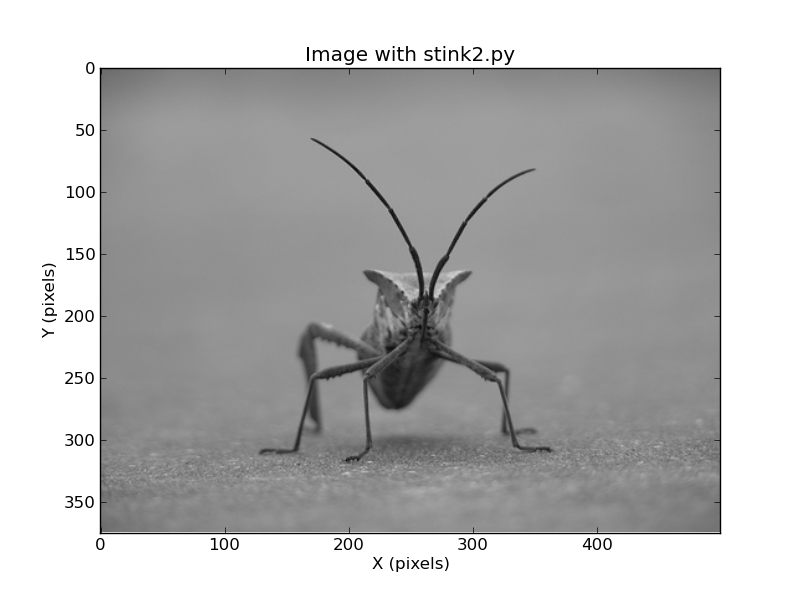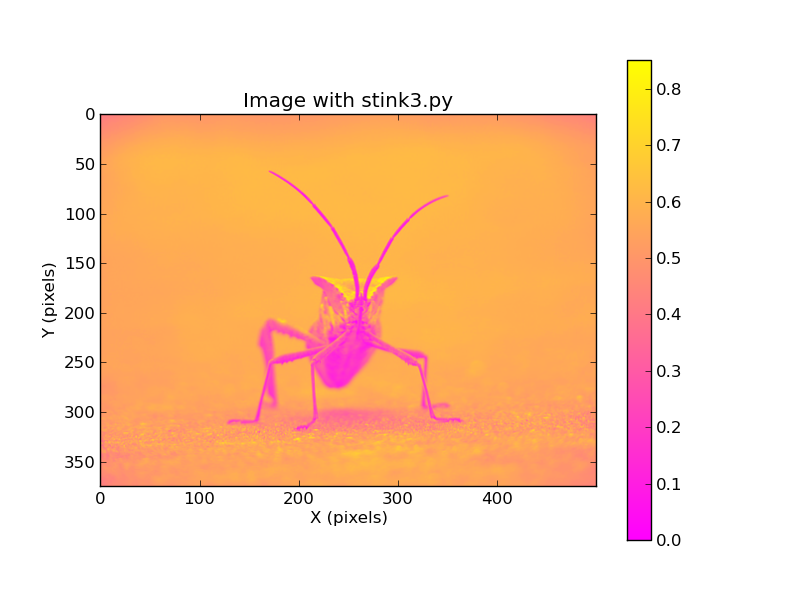Image rendering using python: matplotlib and other things.
Here I explore some image display and computation methods using python.
- The stinkbug.
- Starting with the matplotlib tutorial.
- Adding things and filling in gaps.
The stinkbug.
The peculiar name of this section derives from the title of a
sample image (stinkbug.png) that I found in a
matplotlib tutorial on how to use the imshow() task to
make image plot. I downloaded the PNG file stinkbug.png
and stored it in my TDATA location. Because the file is very
small (unlike my FITS files), I decided to store it in
the run diretory:
% got
% cd T_runs/Image_Render/ex1_stinker/S
% ls
stinkbug.png
I can do experiments in the upper directory, but important notes and
scripts I'll keep in the save directory (S) with stinkbug.png. The
first thing I do, is use some of the stuff I have already been playing
with to learn about stinkbug.png:
% gs.py stinkbug.png
% display gs.png
% identify stinkbug.png
stinkbug.png PNG 500x375 500x375+0+0 8-bit DirectClass 108KB 0.000u 0:00.000
% display stinkbug.png
I used gs.py (my little baby image-rendering code) tp make a
plot of the imag with some axes and some overplotting. This looks
fine. I use the ImageMagic "identify" routine to learn that the
image has a size of 500x375 pixels. I use the ImageMagic "display"
routine to view stinkbug.png directly. I see that the dark parts of
the image have pixel values <50 and the bright parts have pixel
values >175, and hence I confirm that I have an 8-bit image with
pixel data numbers in the expexted range of 0-256 (0 to 2^8).
Finally, I since stinkbug is small, I decided to put a copy of
it in my python code directory. This is where I began the
simple gs.py code in python/implots (IMage PLOTS). I will leave
gs.py alone, but I'll start building plot codes with stinkbug, and
then work up to making image plots with the other image file
there named n3379_B.png (the I made manually using ds9).
Some other interesting points I learned as I
read the page presenting stinkbug.png is:
- Color PNG images are usually referrrd to as RGB or RGBA
(where the A referes to a transparency channel).
- grey scale images are just one channel
- the PNG is called 24-bit becasue it uses THREE 8-bit
images: one each for R, G, B.
As a first exercise with stinkbug.png, I move implots/gs.py
into the subdir stink1/stink1.py and I just hack out some
of the overploting parts. I just want to insure that all of
that stuff works properl, then I'll do the same job using the
methods used in the matplotlib tutorial. When I did this
I could run the program as:
% stink1.py stinkbug.png
Input file: stinkbug.png
Type for image is type 'instance'
Type for arr is type 'numpy.ndarray'
Use to view your plot:
display stink.png
And when I use the display line I see a good looking plot of the
stinkbug image with axes that tell me the pixel positions in X,Y.
Notice that I did add a copule new things to the code: statements
that tell me the type of the variables I created named "image"
and "arr'. I see that image is an instance (???), and arr
is a numpy data array (numpy.ndarray).
Starting with the matplotlib tutorial.
I followed
the matplotlib tutorial on the imshow module to build the
code on codes/python/implots/stink2/stink2.py. I added a few
lines to make some axis labels and create an output plot file.
 |
The image made with stinkbug.png using stink2.py. The code
is simple, but I show it here as a record of something that worked.
#!/usr/bin/python
#
# Here I implement things from matplotlib tutorial at
# http://matplotlib.org/users/image_tutorial.html
#
# To run: stink2.py stinkbug.png
from sys import argv
script_name, pngname = argv
import matplotlib.pyplot as plt
import matplotlib.image as mpimg
import numpy as np
# read the image file
img=mpimg.imread(pngname)
# Make the image plot
imgplot = plt.imshow(img)
# label the axes
label_main = "Image with stink2.py"
label_xaxis = "X (pixels)"
label_yaxis = "Y (pixels)"
plt.title(label_main)
plt.xlabel(label_xaxis)
plt.ylabel(label_yaxis)
plt.savefig('stink.png')
print '\nUse to view your plot:\ndisplay stink.png\n'
|
Adding things and filling in gaps.
Here we start to fill in more things. I create a single-channel
numpy array and plot it with a color lookup table. After
some searching around, I found the
names of the available lookup tables. As shown below, I make
a new color table, but also I add a colorbar for that table. Perhaps
the most important thing to notice is that (somehow) my pixel
values are now in the range 0 to 1.
 |
The image made with stinkbug.png using stink3.py. The important
thing to know here is that I changed the pixel scale to 0-1, and the
code that did this is:
# read the image file
img=mpimg.imread(pngname)
# Now build a numpy array
lum_img = img[:,:,0]
print "Type for lum_img = %s" % (type(lum_img))
# lum_img is a single channel image (the B part of RGB?)
As usual, this important step is glossed over in the tutorial, but
this appears to have involved something called "array slicing".
|
back to calling page

